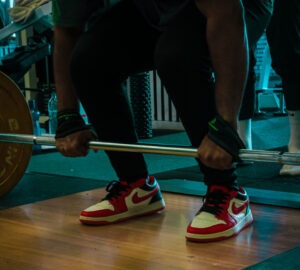Words - 965
Reading Time - 4 minutes and 3 seconds
For our fitness journey, every choice we make, no matter how small, can have a significant impact on our workout experience and results. One such choice that often sparks debate among fitness enthusiasts is whether to work out with or without shoes. While both options have their advocates, each comes with its own set of benefits and considerations. In this comprehensive guide, we’ll delve into the advantages of working out with and without shoes, shedding light on the potential implications for your fitness journey.
The Benefits of Working Out with Shoes:
- Enhanced Stability and Support: Wearing shoes while working out provides essential stability and support, especially during activities that involve lateral movements or heavy lifting. Properly fitted athletic shoes with supportive soles help distribute weight evenly and reduce the risk of injury by providing a stable base for dynamic movements.
- Shock Absorption: Quality athletic shoes are designed with cushioning materials that absorb impact and reduce stress on joints, such as the knees and ankles. This shock absorption can be particularly beneficial during high-impact exercises like running, jumping, or plyometrics, helping to prevent injuries and alleviate discomfort.
 Improved Grip and Traction: The outsoles of athletic shoes are engineered to provide superior grip and traction on various surfaces, including gym floors and outdoor terrain. This enhanced traction enhances stability and confidence during workouts, allowing you to focus on proper form and technique without slipping or sliding.
Improved Grip and Traction: The outsoles of athletic shoes are engineered to provide superior grip and traction on various surfaces, including gym floors and outdoor terrain. This enhanced traction enhances stability and confidence during workouts, allowing you to focus on proper form and technique without slipping or sliding.
- Protection from Injuries: Shoes act as a barrier between your feet and potential hazards on the gym floor, such as sharp objects, moisture, or bacteria. By shielding your feet from these external factors, athletic shoes help reduce the risk of cuts, abrasions, and infections, ensuring a safer and more hygienic workout environment.
- Supportive Features: Many athletic shoes come equipped with additional features, such as arch support, ankle stabilization, and pronation control, designed to address specific biomechanical needs and enhance overall comfort and performance. These supportive features can be particularly beneficial for individuals with pre-existing foot conditions or structural imbalances.
The Benefits of Working Out Without Shoes:
- Improved Foot Strength and Mobility: Exercising barefoot allows your feet to move more naturally and engage the muscles, tendons, and ligaments that may be underutilized when wearing shoes. Over time, this can lead to improved foot strength, flexibility, and proprioception, enhancing overall balance and stability.
- Enhanced Sensory Feedback: Without the barrier of shoes, your feet have direct contact with the ground, allowing for greater sensory feedback and proprioceptive awareness. This heightened sensory input helps improve neuromuscular control and coordination, allowing you to make precise adjustments in movement and technique.
- Better Biomechanics: Working out barefoot encourages a more natural gait and posture, as your feet can adapt to the contours of the ground and make subtle adjustments in response to varying surfaces. This can help correct imbalances, alleviate pressure on joints, and reduce the risk of overuse injuries associated with repetitive movements.
- Increased Circulation: Going barefoot promotes better blood circulation in the feet and lower limbs, as there are no restrictive shoe structures impeding the flow of blood and lymphatic fluid. Improved circulation can aid in recovery, reduce muscle soreness, and enhance overall foot health.
- Cost Savings: Let’s face it—quality athletic shoes can be expensive. By opting to work out barefoot, you can bypass the need for specialized footwear altogether, saving money in the long run while still reaping the benefits of regular exercise.
Considerations for Working Out with or Without Shoes:
While both options offer distinct advantages, it’s essential to consider your
individual preferences, fitness goals, and specific workout routines when deciding whether to work out with or without shoes. Here are a few key
considerations to keep in mind:
- Exercise Type: Certain exercises may be better suited for barefoot training, such as yoga, Pilates, or bodyweight exercises, where stability, balance, and flexibility are paramount. Conversely, activities like weightlifting, running, or high-intensity interval training (HIIT) may benefit from the support and protection provided by athletic shoes.
- Surface Conditions: Pay attention to the surface conditions of your workout environment, as certain factors such as temperature, texture, and cleanliness can influence your decision to wear shoes or go barefoot. While a clean, padded gym floor may be conducive to barefoot training, outdoor environments or gym floors with potential hazards may warrant the use of shoes for safety reasons.
- Personal Preference: Ultimately, the choice to work out with or without shoes should align with your personal comfort level, preferences, and individual biomechanical needs. Experiment with both options and listen to your body to determine what feels most comfortable and effective for you.
Conclusion:
Whether you prefer the stability and support of athletic shoes or the freedom and flexibility of barefoot training, the benefits of working out extend far beyond footwear choices. By understanding the advantages of both options and considering your unique circumstances, you can tailor your workout routine to suit your needs and maximize your fitness potential. So, lace up your shoes or kick them off—whatever path you choose, remember that the journey to a healthier, stronger you begins with every step you take, with or without shoes.
In the city of joy, Kolkata, fitness enthusiasts abound and gyms beckon with promises of strength and vitality, the choice to work out with or without shoes is just one of many decisions we face on our fitness journey. Whether you’re exploring Gyms in Kolkata or seeking the Best Gyms in Kolkata for your workout needs, the benefits of working out extend far beyond the confines of footwear preferences. So, lace up your shoes or kick them off—whatever path you choose, remember that every step you take, with or without shoes, brings you closer to your fitness goals.

